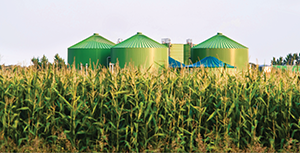 The tremendous push for electric vehicles to help meet net-zero carbon goals largely ignores the reality that internal combustion engines make up a large majority of the current—and the projected future—vehicle fleet—and the fact that zero emission at the tailpipe does not equate to zero emissions in the carbon life cycle. What’s more, there are a number of applications where forcing an EV solution is impractical, especially since other solutions are ready to meet functional needs as well as carbon emissions reduction goals.
The tremendous push for electric vehicles to help meet net-zero carbon goals largely ignores the reality that internal combustion engines make up a large majority of the current—and the projected future—vehicle fleet—and the fact that zero emission at the tailpipe does not equate to zero emissions in the carbon life cycle. What’s more, there are a number of applications where forcing an EV solution is impractical, especially since other solutions are ready to meet functional needs as well as carbon emissions reduction goals.
A new Fuels Institute white paper, “Assessment of Biofuels Policy: Effectiveness of Emissions Reductions,” explores this issue in detail, focusing on true carbon reduction performance based on life cycle. It covers fuel ethanol, biodiesel, renewable diesel and gasoline, hydrogen and R80B20. It also evaluates the policies that affect these fuels, the availability of feedstocks to expand their market share and the vehicle and infrastructure capabilities of accommodating such an expansion.
The report notes that zero-emission vehicle (ZEV) penetration will be marginal over the next decade and largely hinge on infrastructure, range anxiety and price constraints. The light-duty vehicle fleet, which numbered about 260.58 million vehicles in 2020, is expected to grow to about 284.7 million vehicles by 2030. The projection is that 76.8% of these vehicles will be gasoline powered, 5.2% will be ethanol/flex fuel, 2.5% will be diesel, 5.1% will be hybrid gasoline, 1.4% will be plug-in hybrid electric vehicles and 8.8% will be EVs.
There are 300 million combustion engine vehicles, and they’re going to continue emitting carbon unless we figure out a low-carbon fuel option."
“If we’re going to decarbonize transportation, you can’t wait for technology shifts,” said John Eichberger, executive director, Fuels Institute. “There are 300 million combustion engine vehicles, and they’re going to continue emitting carbon unless we figure out a low-carbon fuel option. This is the only viable low-carbon option we have. We wanted to quantify what that carbon intensity potential was, and what the opportunities were to lower carbon over time. Let’s see where we’re heading, and then explore the policies and regulations hindering our ability to leverage that carbon intensity benefit.”
Biofuels have already helped to significantly reduce CO2 emissions in the U.S. transportation sector. For example, the increased use of natural gas has made electric generation far more carbon friendly. As covered in the report, carbon reductions from ethanol, biodiesel and renewable diesel were just over 90 MMT, which is equal to about $251 per metric ton of CO2 emission reductions in 2019. However, there is more work to be done to meet future net-zero carbon goals.
CARBON INTENSITY MODELS
As the report details, the key to meeting net-zero goals is tied heavily to life-cycle carbon intensity models, which are not universal and are highly subjective.
Life cycle is important in that carbon enters the environment through the entire cycle of a solution from the raw materials through production and not just as a vehicle moves down the road. This can be impacted by landuse issues, and with fuels, this can come down to the choice of one feedstock over another having a huge impact on carbon intensity.
 The U.S., Canada and China pull from the Greenhouse Gases, Regulated Emissions and Energy Use in Transportation (GREET) model, while Europe pulls from another model. The viability of any solution can vary greatly depending upon the model. The California Air Resources Board model is generally centered on GREET, but the Fuels Institute report notes it tends to be less life-cycle critical of electricity pathways compared to biofuel pathways.
The U.S., Canada and China pull from the Greenhouse Gases, Regulated Emissions and Energy Use in Transportation (GREET) model, while Europe pulls from another model. The viability of any solution can vary greatly depending upon the model. The California Air Resources Board model is generally centered on GREET, but the Fuels Institute report notes it tends to be less life-cycle critical of electricity pathways compared to biofuel pathways.
“There’s a lot of conflict and contradictory approaches to life-cycle analyses (LCA). What we really need is for EPA to establish a LCA model that’s transparent, repeatable and dispensable,” said Eichberger. “Then you can run everything through that as a baseline. Maybe it’s the GREET model, and I think it should be. Is it perfect? Of course not. But if we’re comparing everything you use in the same model, at least you have apples to apples. The report shows the difference between GREET and Germany’s model. Your carbon intensity score with different feedstocks is ridiculously different without having some consistency in how you measure it.”
AN OVERLOOKED SOLUTION
The biofuels associations are confident advanced versions of their fuels can meet net-zero carbon goals if given the opportunity. Not only are the fuels low-carbon emitting but there are clear pathways to reducing carbon intensity in the full life cycle through techniques such as carbon sequestration (capturing carbon from the process and trapping it where it can’t escape in the environment, such as underground). Ethanol, for example, has tremendous benefits in carbon intensity from this approach. The oil companies are also confident in their ability to produce and distribute biofuels, reducing their own carbon intensity throughout the production process. So why do biofuels get so little consideration compared to EVs? Is it an educational challenge?
What we really need is for EPA to establish a LCA model that’s transparent, repeatable and dispensable."
“I really don’t think we need a lot more education,” said Eichberger. “What we do need is to break this logjam that the only path to lower carbon is electric vehicles. There’s such an animosity to having any conversation about liquid fuels and combustion engines [among various circles], and the leaders in power right now don’t want to talk about it.”
According to Eichberger, getting them to talk about it comes down to forcing them to address the elephant in the room. “They’re abrogating the responsibility to take care of the environment by not addressing 99% of the market and putting all their eggs on a market that might—or might not—develop over the next 30 years,” he said. “We have millions of legacy vehicles now, and millions more coming to the market in the next 20 years—what are you going to do about them? You can’t ignore them. Once they open their ears, then you start talking about solutions. But we have a problem of not being able to have a conversation right now.”
Download the free white paper at www.fuelsinstitute.org.